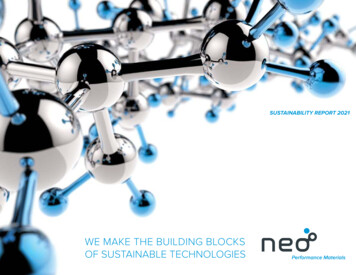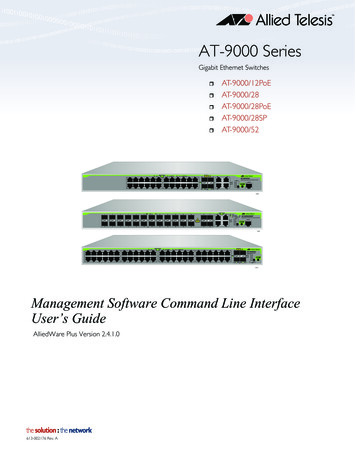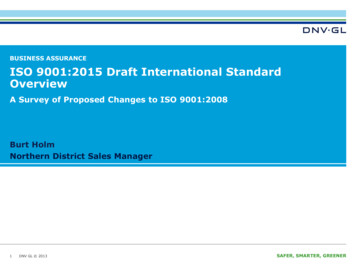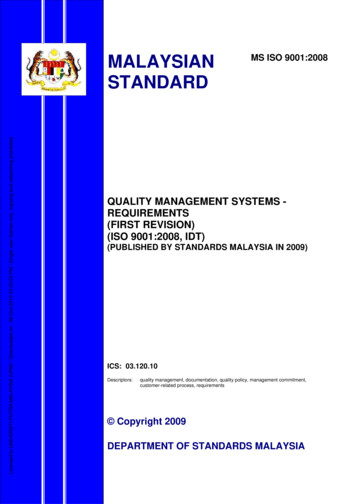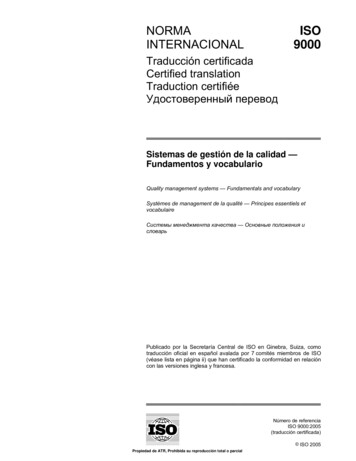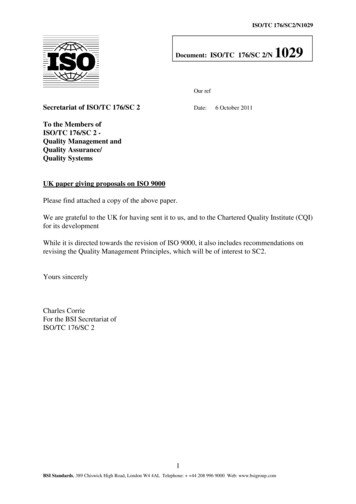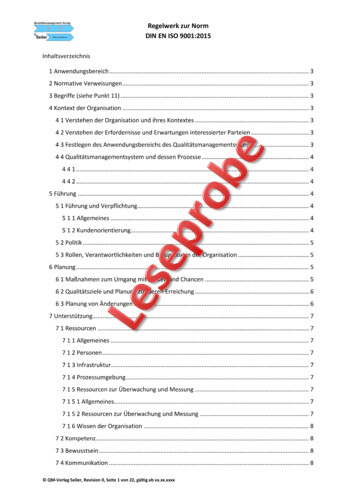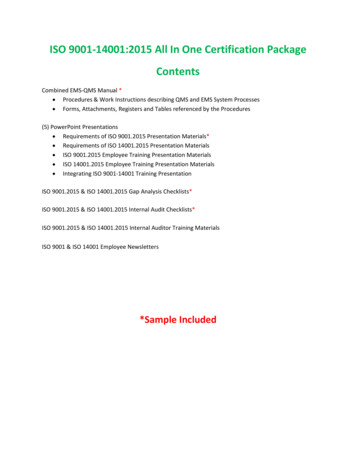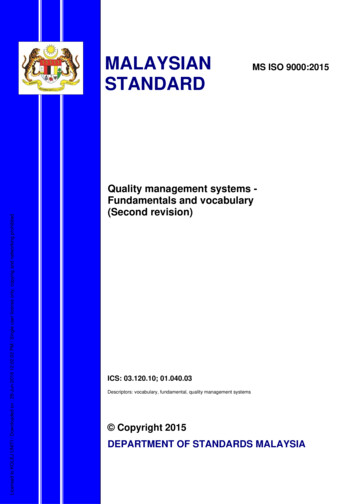
Transcription
Licensed to KOLEJ UNITI / Downloaded on : 28-Jun-2016 12:02:02 PM / Single user license only, copying and networking prohibitedMALAYSIANSTANDARDMS ISO 9000:2015Quality management systems Fundamentals and vocabulary(Second revision)ICS: 03.120.10; 01.040.03Descriptors: vocabulary, fundamental, quality management systems Copyright 2015DEPARTMENT OF STANDARDS MALAYSIA
DEVELOPMENT OF MALAYSIAN STANDARDSThe Department of Standards Malaysia (STANDARDS MALAYSIA) is the nationalstandards and accreditation body of Malaysia.The main function of STANDARDS MALAYSIA is to foster and promote standards,standardisation and accreditation as a means of advancing the national economy, promotingindustrial efficiency and development, benefiting the health and safety of the public, protectingthe consumers, facilitating domestic and international trade and furthering internationalcooperation in relation to standards and standardisation.Malaysian Standards (MS) are developed through consensus by committees which comprisebalanced representation of producers, users, consumers and others with relevant interests,as may be appropriate to the subject at hand. To the greatest extent possible, MalaysianStandards are aligned to or are adoption of international standards. Approval of a standard asa Malaysian Standard is governed by the Standards of Malaysia Act 1996 [Act 549].Malaysian Standards are reviewed periodically. The use of Malaysian Standards is voluntaryexcept in so far as they are made mandatory by regulatory authorities by means ofregulations, local by-laws or any other similar ways.Licensed to KOLEJ UNITI / Downloaded on : 28-Jun-2016 12:02:02 PM / Single user license only, copying and networking prohibitedFor the purposes of Malaysian Standards, the following definitions apply:Revision: A process where existing Malaysian Standard is reviewed and updated whichresulted in the publication of a new edition of the Malaysian Standard.Confirmed MS: A Malaysian Standard that has been reviewed by the responsible committeeand confirmed that its contents are current.Amendment: A process where a provision(s) of existing Malaysian Standard is altered. Thechanges are indicated in an amendment page which is incorporated into the existing MalaysianStandard. Amendments can be of technical and/or editorial nature.Technical corrigendum: A corrected reprint of the current edition which is issued to correcteither a technical error or ambiguity in a Malaysian Standard inadvertently introduced either indrafting or in printing and which could lead to incorrect or unsafe application of the publication.NOTE: Technical corrigenda are not to correct errors which can be assumed to have no consequences in the applicationof the MS, for example minor printing errors.STANDARDS MALAYSIA has appointed SIRIM Berhad as the agent to develop, distributeand sell Malaysian Standards.For further information on Malaysian Standards, please contact:Department of Standards MalaysiaMinistry of Science, Technology and InnovationLevel 1 & 2, Block 2300, Century SquareJalan Usahawan63000 CyberjayaSelangor Darul EhsanMALAYSIATel: 60 3 8318 0002Fax: 60 3 8319 3131http://www.jsm.gov.myE-mail: central@jsm.gov.myORSIRIM Berhad(Company No. 367474 - V)1, Persiaran Dato’ MenteriSection 2, P. O. Box 703540700 Shah AlamSelangor Darul EhsanMALAYSIATel: 60 3 5544 6000Fax: 60 3 5510 8095http://www.sirim.myE-mail: msonline@sirim.my
PageCommittee representation.iiNational foreword .iiiForeword. ivIntroduction.v1Licensed to KOLEJ UNITI / Downloaded on : 28-Jun-2016 12:02:02 PM / Single user license only, copying and networking prohibited23Scope. 1Fundamental concepts and quality management principles. 12.1General. 1Fundamental concepts. 22.22.2.1Quality. 22.2.2Quality management system. 22.2.3Context of an organization. 22.2.4Interested parties. 2Support. 22.2.52.3Quality management principles. 32.3.1Customer focus. 32.3.2Leadership. 4Engagement of people. 52.3.32.3.4Process approach. 6Improvement. 62.3.52.3.6Evidence-based decision making. 72.3.7Relationship management. 8Developing the QMS using fundamental concepts and principles. 92.42.4.1QMS model. 9Development of a QMS. 92.4.22.4.3QMS standards, other management systems and excellence models. 10Terms and definitions.103.1Terms related to person or people. 10Terms related to organization. 113.23.3Terms related to activity. 133.4Terms related to process. 153.5Terms related to system. 163.6Terms related to requirement. 18Terms related to result. 203.73.8Terms related to data, information and document. 233.9Terms related to customer. 253.10 Terms related to characteristic. 263.11 Terms related to determination. 273.12 Terms related to action. 293.13 Terms related to audit. 30Annex A (informative) Concept relationships and their graphical representation.33Bibliography. 47Alphabetical index of terms.49 i
MS ISO 9000:2015Committee representationLicensed to KOLEJ UNITI / Downloaded on : 28-Jun-2016 12:02:02 PM / Single user license only, copying and networking prohibitedThe Industry Standards Committee on Quality Management and Quality Assurance (ISC Y) under whose authority thisMalaysian Standard was adopted, comprises representatives from the following organisations:Construction Industry Development Board MalaysiaDepartment of Standards MalaysiaFederation of Malaysian ManufacturersInstitute of Quality MalaysiaMalaysia Productivity CorporationMalaysian Agricultural Research and Development InstituteMalaysian Association of Standards UsersMalaysian Institute of ChemistryMalaysian International Chamber of Commerce and IndustryMedical Device Authority, Ministry of Health MalaysiaNational Pharmaceutical Control BureauScience and Technology Research Institute for DefenceSIRIM Berhad (National Metrology Laboratory)SIRIM Berhad (Secretariat)SIRIM Berhad (Standards Research and Management Centre)SIRIM QAS International Sdn BhdThe Electrical and Electronics Association of MalaysiaThe Institution of Engineers, MalaysiaUniversiti Utara MalaysiaThe Technical Committee on Quality Management and Quality Assurance - TC 2 on Quality Systems whichrecommended the adoption of the ISO Standard as Malaysian Standard consists of representatives from the followingorganisations:Construction Industry Development Board MalaysiaDepartment of Standards MalaysiaFederation of Malaysian ManufacturersInstitute of Quality MalaysiaMalaysian Administrative, Modernisation and Management Planning UnitMalaysian International Chamber of Commerce and IndustryScience and Technology Research Institute for DefenceSIRIM Berhad (Secretariat)SIRIM QAS International Sdn BhdUniversiti Utara Malaysiaii STANDARDS MALAYSIA 2015 - All rights reserved
MS ISO 9000:2015National forewordThe adoption of the ISO Standard as a Malaysian Standard was recommended by theTechnical Committee on Quality Management and Quality Assurance - TC 2 on QualitySystems under the authority of the Industry Standards Committee on Quality Management andQuality Assurance.This Malaysian Standard is identical with ISO 9000:2015, Quality management systems Fundamentals and vocabulary, published by the International Organization for Standardization(ISO). However, for the purposes of this Malaysian Standard, the following apply:a)in the source text, "this International Standard" should read "this Malaysian Standard";andb)the comma which is used as a decimal sign (if any), to read as a point.Licensed to KOLEJ UNITI / Downloaded on : 28-Jun-2016 12:02:02 PM / Single user license only, copying and networking prohibitedThis Malaysian Standard cancels and replaces MS ISO 9000:2005, Quality managementsystems - Fundamentals and vocabulary (First revision).Compliance with a Malaysian Standard does not of itself confer immunity from legal obligations.NOTE. IDT on the front cover indicates an identical standard i.e. a standard where the technical content,structure, and wording (or is an identical translation) of a Malaysian Standard is exactly the same as in anInternational Standard or is identical in technical content and structure although it may contain the minimaleditorial changes specified in clause 4.2 of ISO/IEC Guide 21-1. STANDARDS MALAYSIA 2015 - All rights reservediii
MS ISO 9000:2015 ForewordISO (the International Organization for Standardization) is a worldwide federation of national standardsbodies (ISO member bodies). The work of preparing International Standards is normally carried outthrough ISO technical committees. Each member body interested in a subject for which a technicalcommittee has been established has the right to be represented on that committee. Internationalorganizations, governmental and non-governmental, in liaison with ISO, also take part in the work.ISO collaborates closely with the International Electrotechnical Commission (IEC) on all matters ofelectrotechnical standardization.The procedures used to develop this document and those intended for its further maintenance aredescribed in the ISO/IEC Directives, Part 1. In particular the different approval criteria needed for thedifferent types of ISO documents should be noted. This document was drafted in accordance with theeditorial rules of the ISO/IEC Directives, Part 2 (see www.iso.org/directives).Licensed to KOLEJ UNITI / Downloaded on : 28-Jun-2016 12:02:02 PM / Single user license only, copying and networking prohibitedAttention is drawn to the possibility that some of the elements of this document may be the subject ofpatent rights. ISO shall not be held responsible for identifying any or all such patent rights. Details ofany patent rights identified during the development of the document will be in the Introduction and/oron the ISO list of patent declarations received (see www.iso.org/patents).Any trade name used in this document is information given for the convenience of users and does notconstitute an endorsement.For an explanation on the meaning of ISO specific terms and expressions related to conformityassessment, as well as information about ISO’s adherence to World Trade Organization (WTO) principlesin the Technical Barriers to Trade (TBT) see the following URL: www.iso.org/iso/foreword.html.The committee responsible for this document is Technical Committee ISO/TC 176, Quality managementand quality assurance, Subcommittee SC 1, Concepts and terminology.This fourth edition cancels and replaces the third edition (ISO 9000:2005), which has beentechnically revised.iv STANDARDS MALAYSIA 2015 - All rights reserved
MS ISO 9000:2015 IntroductionThis International Standard provides the fundamental concepts, principles and vocabulary for qualitymanagement systems (QMS) and provides the foundation for other QMS standards. This InternationalStandard is intended to help the user to understand the fundamental concepts, principles andvocabulary of quality management, in order to be able to effectively and efficiently implement a QMSand realize value from other QMS standards.This International Standard proposes a well-defined QMS, based on a framework that integratesestablished fundamental concepts, principles, processes and resources related to quality, in orderto help organizations realize their objectives. It is applicable to all organizations, regardless of size,complexity or business model. Its aim is to increase an organization’s awareness of its duties andcommitment in fulfilling the needs and expectations of its customers and interested parties, and inachieving satisfaction with its products and services.Licensed to KOLEJ UNITI / Downloaded on : 28-Jun-2016 12:02:02 PM / Single user license only, copying and networking prohibitedThis International Standard contains seven quality management principles supporting the fundamentalconcepts described in 2.2. In 2.3, for each quality management principle, there is a “statement”describing each principle, a “rationale” explaining why the organization would address the principle,“key benefits” that are attributed to the principles, and “possible actions” that an organization can takein applying the principle.This International Standard contains the terms and definitions that apply to all quality managementand QMS standards developed by ISO/TC 176, and other sector-specific QMS standards based on thosestandards, at the time of publication. The terms and definitions are arranged in conceptual order, withan alphabetical index provided at the end of the document. Annex A includes a set of diagrams of theconcept systems that form the concept ordering.NOTEGuidance on some additional frequently-used words in the QMS standards developed by ISO/TC 176,and which have an identified dictionary meaning, is provided in a glossary available at: http://www.iso.org/iso/03 terminology used in iso 9000 family.pdf STANDARDS MALAYSIA 2015 - All rights reserved v
MS ISO 9000:2015INTERNATIONALSTANDARD ISO 9000:2015(E)MS ISO 9000:2015MS ISO 9000:2015Quality management systems — Fundamentals andvocabulary1 ScopeThis International Standard describes the fundamental concepts and principles of quality managementwhich are universally applicable to the following:— organizations seeking sustained success through the implementation of a quality management system;— customers seeking confidence in an organization’s ability to consistently provide products andservices conforming to their requirements;Licensed to KOLEJ UNITI / Downloaded on : 28-Jun-2016 12:02:02 PM / Single user license only, copying and networking prohibited— organizations seeking confidence in their supply chain that product and service requirements willbe met;— organizations and interested parties seeking to improve communication through a commonunderstanding of the vocabulary used in quality management;— organizations performing conformity assessments against the requirements of ISO 9001;— providers of training, assessment or advice in quality management;— developers of related standards.This International Standard specifies the terms and definitions that apply to all quality managementand quality management system standards developed by ISO/TC 176.2 Fundamental concepts and quality management principles2.1 GeneralThe quality management concepts and principles described in this International Standard givethe organization the capacity to meet challenges presented by an environment that is profoundlydifferent from recent decades. The context in which an organization works today is characterized byaccelerated change, globalization of markets and the emergence of knowledge as a principal resource.The impact of quality extends beyond customer satisfaction: it can also have a direct impact on theorganization’s reputation.Society has become better educated and more demanding, making interested parties increasinglymore influential. By providing fundamental concepts and principles to be used in the development ofa quality management system (QMS), this International Standard provides a way of thinking about theorganization more broadly.All concepts, principles and their interrelationships should be seen as a whole and not in isolation ofeach other. No individual concept or principle is more important than another. At any one time, findingthe right balance in application is critical. STANDARDS MALAYSIA 2015 - All rights reserved 1
MS ISO 9000:2015 2.2 Fundamental concepts2.2.1QualityAn organization focused on quality promotes a culture that results in the behaviour, attitudes, activitiesand processes that deliver value through fulfilling the needs and expectations of customers and otherrelevant interested parties.The quality of an organization’s products and services is determined by the ability to satisfy customersand the intended and unintended impact on relevant interested parties.The quality of products and services includes not only their intended function and performance, butalso their perceived value and benefit to the customer.2.2.2Quality management systemA QMS comprises activities by which the organization identifies its objectives and determines theprocesses and resources required to achieve desired results.Licensed to KOLEJ UNITI / Downloaded on : 28-Jun-2016 12:02:02 PM / Single user license only, copying and networking prohibitedThe QMS manages the interacting processes and resources required to provide value and realize resultsfor relevant interested parties.The QMS enables top management to optimize the use of resources considering the long and short termconsequences of their decision.A QMS provides the means to identify actions to address intended and unintended consequences inproviding products and services.2.2.3Context of an organizationUnderstanding the context of the organization is a process. This process determines factors whichinfluence the organization’s purpose, objectives and sustainability. It considers internal factors such asvalues, culture, knowledge and performance of the organization. It also considers external factors suchas legal, technological, competitive, market, cultural, social and economic environments.Examples of the ways in which an organization’s purpose can be expressed include its vision, mission,policies and objectives.2.2.4Interested partiesThe concept of interested parties extends beyond a focus solely on the customer. It is important toconsider all relevant interested parties.Part of the process for understanding the context of the organization is to identify its interested parties.The relevant interested parties are those that provide significant risk to organizational sustainability iftheir needs and expectations are not met. Organizations define what results are necessary to deliver tothose relevant interested parties to reduce that risk.Organizations attract, capture and retain the support of the relevant interested parties they dependupon for their success.2.2.52.2.5.1SupportGeneralTop management support of the QMS and engagement of people enables:— provision of adequate human and other resources;— monitoring processes and results;2 STANDARDS MALAYSIA 2015 - All rights reserved
EMS ISO 9000:2015 — determining and evaluating of risks and opportunities;— implementing appropriate actions.Responsible acquisition, deployment, maintenance, enhancement and disposal of resources support theorganization in achieving its objectives.2.2.5.2PeoplePeople are essential resources within the organization. The performance of the organization isdependent upon how people behave within the system in which they work.Within an organization, people become engaged and aligned through a common understanding of thequality policy and the organization’s desired results.2.2.5.3CompetenceA QMS is most effective when all employees understand and apply the skills, training, education andexperience needed to perform their roles and responsibilities. It is the responsibility of top managementto provide opportunities for people to develop these necessary competencies.Licensed to KOLEJ UNITI / Downloaded on : 28-Jun-2016 12:02:02 PM / Single user license only, copying and networking prohibited2.2.5.4AwarenessAwareness is attained when people understand their responsibilities and how their actions contributeto the achievement of the organization’s objectives.2.2.5.5CommunicationPlanned and effective internal (i.e. throughout the organization) and external (i.e. with relevantinterested parties) communication enhances people’s engagement and increased understanding of:— the context of the organization;— the needs and expectations of customers and other relevant interested parties;— the QMS.2.3 Quality management principles2.3.12.3.1.1Customer focusStatementThe primary focus of quality management is to meet customer requirements and to strive to exceedcustomer expectations.2.3.1.2RationaleSustained success is achieved when an organization attracts and retains the confidence of customersand other relevant interested parties. Every aspect of customer interaction provides an opportunity tocreate more value for the customer. Understanding current and future needs of customers and otherinterested parties contributes to the sustained success of the organization.2.3.1.3Key benefitsSome potential key benefits are:— increased customer value; STANDARDS MALAYSIA 2015 - All rights reserved 3
MS ISO 9000:2015 — increased customer satisfaction;— improved customer loyalty;— enhanced repeat business;— enhanced reputation of the organization;— expanded customer base;— increased revenue and market share.2.3.1.4Possible actionsPossible actions include:— recognize direct and indirect customers as those who receive value from the organization;— understand customers’ current and future needs and expectations;Licensed to KOLEJ UNITI / Downloaded on : 28-Jun-2016 12:02:02 PM / Single user license only, copying and networking prohibited— link the organization’s objectives to customer needs and expectations;— communicate customer needs and expectations throughout the organization;— plan, design, develop, produce, deliver and support products and services to meet customer needsand expectations;— measure and monitor customer satisfaction and take appropriate actions;— determine and take action on relevant interested parties’ needs and appropriate expectations thatcan affect customer satisfaction;— actively manage relationships with customers to achieve sustained success.2.3.22.3.2.1LeadershipStatementLeaders at all levels establish unity of purpose and direction and create conditions in which people areengaged in achieving the organization’s quality objectives.2.3.2.2RationaleCreation of unity of purpose and the direction and engagement of people enable an organization toalign its strategies, policies, processes and resources to achieve its objectives.2.3.2.3Key benefitsSome potential key benefits are:— increased effectiveness and efficiency in meeting the organization’s quality objectives;— better coordination of the organization’s processes;— improved communication between levels and functions of the organization;— development and improvement of the capability of the organization and its people to deliverdesired results.4 STANDARDS MALAYSIA 2015 - All rights reserved
) ISO 9000:2015MS2.3.2.4 Possible actionsPossible actions include:— communicate the organization’s mission, vision, strategy, policies and processes throughout theorganization;— create and sustain shared values, fairness and ethical models for behaviour at all levels of theorganization;— establish a culture of trust and integrity;— encourage an organization-wide commitment to quality;— ensure that leaders at all levels are positive examples to people in the organization;— provide people with the required resources, training and authority to act with accountability;— inspire, encourage and recognize the contribution of people.2.3.3Licensed to KOLEJ UNITI / Downloaded on : 28-Jun-2016 12:02:02 PM / Single user license only, copying and networking prohibited2.3.3.1Engagement of peopleStatementCompetent, empowered and engaged people at all levels throughout the organization are essential toenhance the organization’s capability to create and deliver value.2.3.3.2RationaleIn order to manage an organization effectively and efficiently, it is important to respect and involveall people at all levels. Recognition, empowerment and enhancement of competence facilitate theengagement of people in achieving the organization’s quality objectives.2.3.3.3Key benefitsSome potential key benefits are:— improved understanding of the organization’s quality objec
This Malaysian Standard cancels and replaces MS ISO 9000:2005, Quality management systems - Fundamentals and vocabulary (First revision). Compliance with a Malaysian Standard does not of it self confer immunity from legal obligations. NOTE. IDT on the front cover indicates an identical standard i.e. a standard where the technical content,

